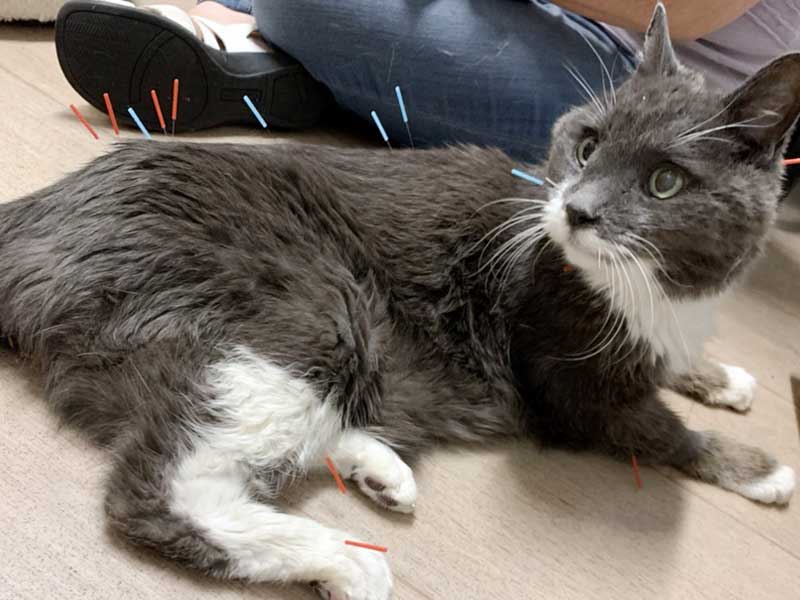Small Animal Veterinary Acupuncture Certification Courses
Basic certification in small animal acupuncture (cEBVAsa) will be achieved after completing two levels of combined online and in-person coursework (90 hours). Each level is comprised of approximately 20 hours of online material followed by 24 hours of in person laboratory and individual evaluation. Treatment of cases are required between levels one and two (three sets of case reports). Course materials must be completed within four years of starting the program. Maintenance of certification will require at least 100 hours of RACE approved acupuncture continuing education every 10 years.
After certification, graduates of EBVA will be eligible to participate in elective courses. If a graduate chooses to take the Level Three Advanced elective, or Acu-Equus certification course, they will be eligible for a 15% discount. If both CEBVAsa and CEBVAeq certifications are completed the graduates will receive the general, cEBVA certification.
Graduates of other certification programs will be eligible to take Level 3: Advanced Elective, and other elective courses, or any of the online coursework from the basic levels. If graduates from other courses wish to achieve the EBVA basic certification (cEBVAsa), they will be required to complete both online sessions, and attend one in-person session.


Note: Students who complete BOTH Small Animal and Equine certifications will have non-limited credentials (cEBVA).
Certification requires participation in both the online and in-person portions. However, individuals who are already certified in acupuncture may purchase the online portion of the course for continuing training in neuro-anatomically based acupuncture. See Online Learning for Practicing Veterinary Acupuncturists.
Evidence Based Veterinary Acupuncture Small Animal Certification Course
Level One: Acu-Alphabet
Online Session One: Neurophysiology of Acupuncture and Points
- Understanding acupuncture science: Neuromodulation Fascial physiology Anatomy basics Myofascial kinetic chains and Reflex loops
- Understanding channels and channel-based arrangement of core acupuncture points: LU, LI, ST, SP PC, TE, BL, KI HT, SI, LR, GB Unpaired channels Paraspinal Points Extra points
- Introduce the layers of acupuncture research behind core acupuncture points: physiological studies, clinical studies and (occasionally), randomized controlled trials
Session One Objectives:
Understand the neurophysiology behind the practice of acupuncture and start memorizing the most basic points that can be safely used to treat most pain-related small animal cases.
Session One Learning Outcomes:
- Prepare an "elevator speech" for why you would like to add acupuncture to your pain management protocols.
- Be able to identify at least 30 acupuncture points based upon anatomic landmarks.
- Identify different levels of treatment along cervical, thoracic, lumbar, sacral and coccygeal spinal regions, and when it would be appropriate to use these points.
Online Session 2: The physical exam through an acupuncture lens
- Review major palpatory landmarks in dogs
- Learn how to assess fascia, and how to perform the JAM exam (Joint, Acupuncture and Motion)
- Become aware of how to communicate to clients and associates about acupuncture, and record the findings from a JAM exam, and an acupuncture treatment. Understand the legal considerations around acupuncture practice.
Session Two Objectives:
Learning the techniques introduced through the JAM exam (joint, acupuncture and motion) will revolutionize a practitioner's diagnostic ability and their approach to ALL cases, whether they are presenting for acupuncture or standard medical practices.
Session Two Learning Outcomes:
- Understand the components of a JAM exam and begin to develop the tactile awareness to gently inquire about pain and other medical conditions in patients.
- Learn to identify myofascial strain patterns, and link these roadmaps to common medical conditions.
- Capture the nuances of an acupuncture treatment in a simple form for medical recordkeeping and client education.
Online Session Three: Acupuncture tools and treatment plans
- Design logical acupuncture treatment combinations using: paraspinal acupuncture anatomy, large motor-group points, peri-articular appendicular points, distal, neuro-immune vascular points, homeostatic points, lymphovascular points, and neurologically rich points.
- Familiarize yourself with the tools of acupuncture: needling basics, electrical stimulation, tools of fascial input, mechanical tools (hands, massagers) Sound waves (tuning fork, shockwave), light therapy.
Session Three Objectives:
Bridging the vocabulary of points with the grammar of an elegant JAM exam, practitioners will arrive at a comprehensive acupuncture treatment plan, and feel empowered to learn and modify their approach with each subsequent treatment.
Session Three Learning Outcomes:
- Design an acupuncture protocol for a specific type of case, with specific findings from a JAM exam.
- Understand alternatives to your established plan, so that your approach may be limber enough to accommodate changes based upon patient tolerance and response.
- Discuss other modalities that can be added to the acupuncture needling practice to expand the treatment, or modify it over time.
A Virtual real-time check in with Faculty and Students will be required the weekend before arriving to in-person course. All online material must be completed before starting the in-person course.
In-Person Curriculum (all laboratory):
Day One:
- Reinforce point locations learning online: first by channel and then by region
- Practice palpating fascia, and myofascial changes in models and on dogs
- Master the techniques of a JAM exam in dogs
Day Two:
- Anatomy lab- deep dive into anatomy and physiology of acupuncture points
- Introduction to acupuncture needles and needling techniques
- Workup canine cases with a JAM exam and start acupuncture treatment
Day Three:
- Workup more canine cases with JAM exam and start acupuncture treatment
- Present your first case and develop the communication skills to discuss acupuncture neurophysiology and treatment recommendations
- Develop confidence to go back to your practice and start cases- three required before level 2
Prior to returning for Level Two: All online materials completed, and three case reports that the student will present on the first day of in-person.
Evidence Based Veterinary Acupuncture Small Animal Certification Course
Level Two: Acu-Athlete & Acu-Integrative Pain
Online Session One: Expanding the alphabet: Acupuncture Points, Channels and Regions
- Learn the named Bladder Line points along the spine, and how they relate to back (Shu) points, and front (Mu) points.
- Learn additional points within the framework of common conditions including pain, mobility and internal medical conditions.
- Learn points on the head. Reinforce the sometimes aligned, and sometimes contradictory goals of treating along acupuncture meridians versus treating along myofascial kinetic chains.
- Learn variations in acupuncture points and treatment in cats compared to dogs.
Session One Objectives:
Increase the size of your acupuncture “alphabet” of points and expand indications for using these points. Add clarity to the channels contribution to point locations. Expand the diagnostic potential of acupuncture points to include internal conditions.
Session One Learning outcomes:
- Increase your lexicon to at least 100 acupuncture points based upon anatomic landmarks.
- Consider when grouping of points along a channel, region or myofascial kinetic chain makes the most sense, versus distributing points according to a broad neuro-physiological framework.
- Be able to recognize points that have a more motor-based effect versus a more neuromodulatory, homeostatic effect, versus effects on complex poly-synaptic reflex loops.
Online Session Two: Designing point formulations for complex cases and Internal Medicine Paradigms for point formula
- Learn sensible approaches to a variety of mobility, pain and internal medicine conditions (while continuing to base all treatments, in part, on what is found in your JAM exam).
- Triage important points into a number that is reasonable to place during a therapeutic window.
- Acupuncture treatments for the following conditions will be presented: neuropathies and IVDD, osteoarthritis, tendon conditions, immune system diseases, gastro-intestinal conditions and nausea/vomiting, laryngeal and respiratory conditions, special sensory systems- hearing, vision, taste, Urinary and Reproductive conditions, metabolic conditions, anesthesia augmentation, dental and orofacial pain diseases, cancer, animal behavior, and palliative care.
Session Two Objectives:
This session introduces a whole new world for the blossoming acupuncturist- adding a diversity of diagnostic and treatment possibilities that formerly might have seemed unreachable. Recognizing the cross-talk between the touchable and un-touchable body systems will permanently transform your medical practice.
Session Two Learning Outcomes:
- Learn about pathophysiology and acupuncture for various mobility, pain and medical conditions, and conditions of the head.
- Note how internal medicine conditions often correlate with JAM exam findings, and why this might be the case.
- Refine your application of point formula to minimize needles, but treat points that overlap with several of the objectives in your exam and treatment.
Online Session 3: Expanding the Boundaries
- “Deepening” needling techniques and exploring TCVM personality traits as they relate to acupuncture
- Learn how personality types and phenotypic patterns can influence disease propensity and response to acupuncture and other environmental cues.
- Balancing cost and quality in veterinary acupuncture.
- Translating and transposing: how to apply basic small animal acupuncture skills to other species.
Session Three Objectives:
In session three the practice of acupuncture has become skilled, and it can now be applied through various types of individuals, clinical and socio-economic settings, and even in less common species. Additional incorporation somato-autonomic reflex loops are incorporated to address a variety of conditions beyond movement and comfort.
Session Three Learning Outcomes:
- Explain how to treat various internal medicine conditions with acupuncture.
- Prepare comparative acupuncture and integrative medicine plans for families from three divergent economic locale, and evaluate the advantages of each.
- Pick a species of your choice and consider how you would transpose points, as well as approach this patient for acupuncture treatment.
Three canine (or feline) cases must be completed between Level 1 and Level 2. At least 2-3 visits per case are required, and a case report (as presented in person at Level 1) will be required for each case.
A Virtual real-time check in with Faculty and Students will be required the weekend before arriving to in-person course. All online material must be completed before starting the in-person course.
In-Person Curriculum:
Day One:
- Re-introductions and knowledge recap from last module (1 hour)
- Laboratory: Case presentations and review of core points (2 hours)
- Laboratory: Mu and Shu points (1 hour)
- Laboratory: New points with emphasis on regions (2 hours)
- Cases: Community derived cases (2 hours)
- Homework: Your TCVM biotype
Day Two:
- Anatomy lab: recap anatomy and add new points
- Laboratory (4 hours): community derived cases
- TCVM personality type and graduation celebration!
Day Three:
- Case presentation and discussion (2 hours)
- Round table: Treating complex cases, adding acupuncture to practice, legal and business topics (2 hours)
- Feline acupuncture: 2-3 hour lab
Evidence Based Veterinary Acupuncture Small Animal Certification Course
Level Three: Advanced Elective
- Electives may be taken by graduates of any acupuncture program
- EBVA graduates receive a 15% discount on elective courses
- Level 3 can be taken as an entirely online course (25 hours of CE credit) or taken in concert with a 3 day in-person laboratory session (50 hours of CE credit)
- In Level 3 it is assumed that you already have a good working knowledge of core acupuncture points
Online Session One: Vocabulary: Deepening the Scientific Database Behind Acupuncture Science
- Basic Sciences Deep Dive: Pain neurophysiology, fascial physiology, proprioception, long and short reflex loops, lymphatic physiology, mechanotransduction, pharmacology, photon and sound-wave non-pharma, motion in non-pharma, diet and supplements.
- Literature Review: Acupuncture research and planning, the complexity of placebo effect in complex interactions, complexity theory.
- Review the neuro-immune function of the parasympathetic nervous system and the global effects of the vagus, as well as visceral pain embryology and common points that stimulate the parasympathetic nervous system.
Session One Objectives:
Strengthen the breadth and depth of your acupuncture acumen and knowledge. Understanding other pharmacological and non-pharmacological interventions that can be added to patient care plans.
Session One Learning outcomes:
- Grasp the scaffolding of basic science underpinning the effects of pharmaceuticals, acupuncture and other physical medicine modalities.
- Explain the bumpy road to evidence-based medicine as it applies to acupuncture, and how it has started to resolve within the last 10 years.
- Describe somato-autonomic reflex loops and identify which acupuncture points are reported to engage somato-autonomic long-loop reflexes to identify and modify organ disease.
Online Session Two: Deep Dive into Pain Medicine, Sports Medicine and Rehabilitation focused Acupuncture
- A scoping review of the pathophysiology and integrative approaches to specific conditions that affect mobility and comfort.
- Fill in missing details around the myofascial kinetic chains described in dogs, horses and humans, and the overlap and differences between these lines and acupuncture meridians.
- Specific acupuncture points and their neurophysiological underpinnings relative to the treatment of mobility and pain will be reviewed and expanded upon.
- An evidence-based approach will be discussed for integrative care of specific joints (hip, stifle, hock, shoulder, elbow, carpus), tendons (iliopsoas, shoulder, achilles), sacro-pelvic disease and working dogs as a general group.
Session Two Objectives:
Compose an elegant integrative treatment plan for various conditions, which will be implemented with attention to the JAM exam, pharmacology, the principles of medical acupuncture, and the cooperation of your patient.
Session Two Learning Outcomes:
- Consider your approach to dogs that are planning to return to athletic activity, including types of treatments, timing of treatments, and return to sporting strength and function.
- Triage a comprehensive acupuncture treatment plan for a dog with both musculoskeletal conditions and other concurrent disease states, using 20 points or less.
- Recognize the integration of multiple techniques for managing complex Musculo-skeletal and neurological cases and be fluent in how to triage interventions in specific cases.
Online Session 3: Complex conditions, Aging, Pain and Immunity
- Become familiar with the far-reaching effects of the neuro-immune-endocrine system and how this plays a role in bodywide functions, including the GI system, microbiome and central nervous system.
- Delve into the realm of acquired conditions, including immune homeostasis, pain amplification associated with various disease states, and descending noxious inhibitory control mechanisms.
- Explore the potential of acupuncture points for interacting with the neuro-immune-endocrine system, and learn the primary players.
- An evidence-based approach will be discussed for integrative care of specific joints (hip, stifle, hock, shoulder, elbow, carpus), tendons (iliopsoas, shoulder, achilles), sacro-pelvic disease and working dogs as a general group.
Session Three Objectives:
Triage for competing and overlapping acupuncture points, along with other physical medicine additions, to treat complex medical, mobility and pain conditions.
Session Three Learning Outcomes:
- Identify and utilize acupuncture points that support the neuro-immune-endocrine homeostatic system for treating complex diseases.
- Learn sensible approaches to a variety of internal medicine conditions (while continuing to base all treatments on what is found in your JAM exam).
- Devise an outcome based measure that could be used to assess patient response to treatment, and discuss how you might implement this in your clinical practice.
Three canine (or feline) cases must be completed and presented at this elective course. Case reports are required for all three.
A Virtual real-time check in with Faculty and Students will be required the weekend before arriving to in-person course. All online material must be completed before starting the in-person course.
In-Person Curriculum:
Day One:
- Introductions and background (1 hour)
- Laboratory- case presentations and review of core points (3 hours)
- Laboratory- Methods of fascial release: (3 hours)
- Station 1: Mechanical techniques- tapping, muscle spindles
- Station 2: Sound: shock-wave and tuning forks
- Station 3: Photons: Photobiomodulation
- Station 4: Acupuncture needles and techniques
- Discussion: Tools, techniques, similarities and differences
Day Two:
- Anatomy lab: The anatomic underpinnings of acupuncture points (4 hours)
- Lunch and case report preparation (2 hours)
- Cases - Sports Medicine focus (4 hours)
- Prepare case presentation
Day Three:
- Cases 8:00 a.m. - 12:00 p.m. - complex condition focus (4 hours)
- Lunch: 2 hours (prepare case presentation)
- Roundtable and case presentation






